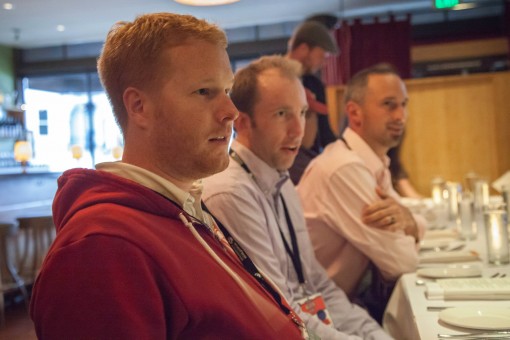I don’t think I’ve shared this much about “what I do for work” with many folks. So here we go…
Chapter 1: Alex King and Crowd Favorite1
I met Alex a few times at various tech events in the area (BarCamp Denver in 2006, Startup Weekend in 2007). We both became familiar with each other through these events were able to keep in touch loosely through our respective blogs (he’s always been a big deal in the WordPress industry).
When Alex moved the Crowd Favorite office to downtown Denver I asked to grab lunch since I was also working downtown. Coincidentally, he was about a year into Crowd Favorite and looking to bring in some help as the team and projects grew. I was also looking to find a great way to get into the internet industry.
I started working for Alex in July 2008 as an account manager supporting incoming requests from existing maintenance and support clients. Given my technical background, I also started working on exploring incoming projects, gathering their requirements, preparing estimates, and handing them off to our project manager. At some point along the way it made sense for me to take on and manage some of the projects myself. At that point I realized I lived and breathed the entire consulting client lifecycle: business acquisition, through project launch, and into ongoing support and maintenance.
In 2009 Charlie Hoehn asked me to share my thoughts on ‘the power of having a personal blog’ for his book “Recession-Proof Graduate” and I wrote: “I went from a no-name blogger to a trusted source, which ultimately landed my dream job.”
What I did at Crowd Favorite was a dream job and continued to be, even as the business and my role evolved. After years of practicing “do what you think is best” and then receiving immediate feedback from Alex, I felt like I really understood how he wanted to run his business. I’ve seen some folks get frustrated with receiving constant feedback on their actions (and inactions) but I saw each email from Alex as free knowledge. I tried to absorb everything and ask clarifying questions which allowed me to grow my understanding and responsibilities. My “Alex King bootcamp” was an amazing learning experience.
Having learned Alex’s ways and preferences, the business’ and industry’s technologies and processes, and mixing in my own experiences and knowledge: there became a point in 2012 where he and I felt like I had a good handle on most of the day-to-day happenings. We hired another project manager (bringing the total to three) to help with my clients and allow me to help with more of the business and take some responsibilities off of Alex.
Unfortunately, this was put to the test earlier this year when Alex had to take a sudden medical leave. To the entire team’s credit, everything at Crowd Favorite kept humming along just fine. I’d say my involvement within the organization during this period is one of the things I’m most proud of.
Chapter 2
I was part of the Crowd Favorite team and helped (and watched) it grow, change, and improve over the past five-and-a-half years. I took on a lot of responsibility in the past year or so and cemented a lot of thoughts about providing excellent client service, successful project management, selling products and services, managing a team, and even running a business (everything from negotiating contracts to hiring employees).
But now I’m looking to do some travel, learn new things, and explore different technologies and industries.
Derek Sivers, founder of CD Baby, put it succinctly: “I realized that the bigger learning and growing challenge for me was letting go, not staying on.”
Kevin Kelly also shared an interesting perspective: “Stewart Brand, who is now 69, has been arranging his life in blocks of 5 years. Five years is what he says any project worth doing will take. From moment of inception to the last good-riddance, a book, a campaign, a new job, a start-up will take 5 years to play through.” Five years is also approximately 10,000 working hours, a milestone Malcolm Gladwell touted as being requisite to becoming “great” at anything.
In the few months after deciding to move along, I had some excellent conversations and ultimately re-discovered a software company in California that I truly believe in. Next week, I will be joining the Enterprise team at GitHub and spending time traveling to and from San Francisco (more on that later).
TTFN
This is not a sudden development. I’ve actually been documenting and handing-off my involvement and responsibilities (to identify potential gaps) and explicitly sharing tacit knowledge with the Crowd Favorite team since early September.
More recently, I’ve also done my best (in addition to everyone else) to provide as much background and detail about the team, its projects, clients, philosophies and processes to the folks at VeloMedia (who recently acquired Crowd Favorite). I’m excited for the expertise and leadership these guys and gals bring to Crowd Favorite and look forward to what the future holds. They’ve asked me to continue to lend my thoughts to them and the project management team (for continuity) and I said I’d be more than happy to.
“I gotta go now. I’ve got a lotta bouncin’ to do! Hoo-hoo-hoo-hoo! T-T-F-N: ta-ta for now!”
That all said, I owe a big “thank you” to the patient clients, interesting prospects, friends of the company, and everyone else I’ve worked with these past few years. It’s been a pleasure.
Most importantly, I owe everything to the entire team at Crowd Favorite (new, old and alumni). I’ve learned a lot, enjoyed the experiences, and have you all to thank for who I am and where I am today.
I’m excited because I know there are great things coming for both myself and Crowd Favorite. If you’d like to follow along, you always find more over there at Crowd Favorite’s blog and here on my own.
- I held plenty of good jobs before I joined Crowd Favorite, but none of them truly feel like chapters in my “career story”; they were more like an Introduction. ↩



